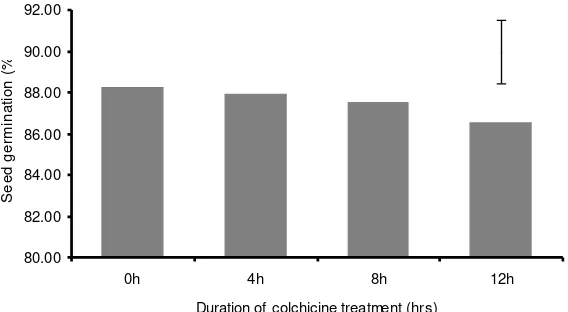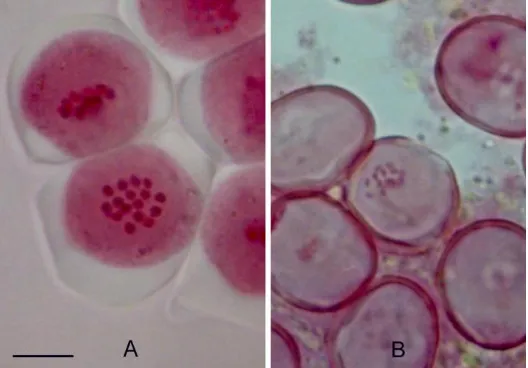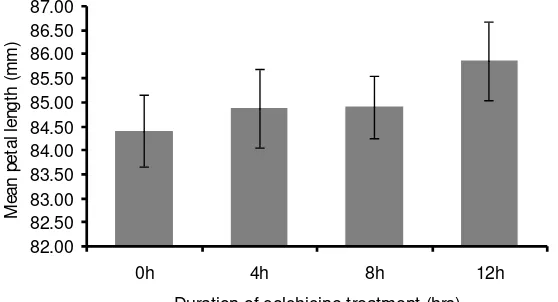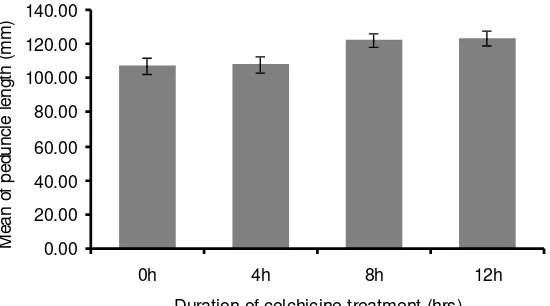International Association for Plant Tissue Culture
and Biotechnology (Australian Branch) Meeting
Duval Conference Centre
University of New England
Armidale, Australia
Towards Sterile Plant Production in Sturt’s Desert Pea (
Swainsona
formosa
) via In Vivo Triploid Plant Production
Zulkarnain, Z., Taji, A., and Prakash, N. School of Rural Science University of New England,
Armidale, NSW, Australia [email protected]
Abstract
Sturt’s Desert Pea, Swainsona formosa, (G.Don) J.Thompson, is an ornamental legume native to Australia. The economic importance of this plant is in its use as a hanging basket or container plant or for cut flowers. The production of large amounts of pollen grains in the flower is a major impediment in the commercialisation of this plant. Petal staining by pollen as well as self-pollination during transport reduces the quality of the flowers. The objective of current work is to produce triploid plants using colchicine, an anti mitotic chemical. Sturt’s Desert Pea seeds were treated with 0.1% colchicine for 0 (untreated), 4, 8 and 12 hours. The seeds were then transferred to distilled water for a further total treatment time of up to 24 hours. After seed germination on moist filter paper in Petri dishes and early seedling development in Jiffy® pots the seedlings were transferred into 20cm pots containing pasteurised
mixture of sand and peat (3:1) in a glasshouse under the temperature of 25-32C and a 16 hour photoperiod. These plants produced flowers within 80 days. The chromosome number of flowers was ascertained in squashed pollen mother cells obtained from approximately 1.3 cm long flower buds, and stained with 1% aceto-orcein. The results indicate that the chromosome number of untreated plants was n = 8. The flowers of colchicine treated plants were emasculated at 14-16 days after floral initiation and were then pollinated with pollen from untreated plants. At the same time untreated plants were also crossed with each other. Seeds were collected from these crosses within 40-45 days. The results indicated that the increase in soaking time reduced the number of germinated seeds although this was not significant. However, the duration of colchicine treatment significantly affected radicle length, microspore size and peduncle length but not petal length. Furthermore, no chromosome doubling was observed at any length of soaking time.
Keywords: legume, ornamental plant, colchicine, chromosome doubling, tetraploid, ploidysation
INTRODUCTION
Sturt’s Desert Pea, Swainsona formosa (G.Don) J.Thompson (syn. Clianthus formosus (G.Don) Ford & Vick.), is an ornamental legume native to Australia
(Williams and Taji, 1991) and is the floral emblem of South Australia (Kirby, 1996a).
The economic importance of this species is its potential use as a hanging basket,
container or cut flower plant (Williams and Taji, 1991; Kirby, 1996a,b). It is not only
in demand in the domestic cut flower market, but also overseas. A market survey
important cut flower markets where Sturt's Desert Pea already has a strong market
(Barth and Bennel, 1989).
However, the commercialisation of Sturt’s Desert Pea as cut flowers is
hampered by petal staining by pollen grains which are shed during transportation,
reducing the flower quality significantly. In addition, during transportation, self
pollination may take place, reducing the vase life of the flowers. Therefore,
developing strategies to produce pollenless plants is the most appropriate method to
solve this problem.
The present study is the first attempt we know so far to produce triploid Sturt’s
Desert Pea using colchicine, an anti-mitotic chemical. The first step in the process is
to produce plants that are tetraploid, by the application of colchicine which acts by
disrupting spindle formation during mitotic cell division. The flowers of treated
plants, upon pollination and fertilisation, will produce seeds that are tetraploid.
Crossing diploid and tetraploid individuals will result in the production of triploids.
MATERIALS AND METHODS
Seeds were soaked for 10 min in 1.0% sodium hyphochlorite (obtained by
diluting 25 mL commercial bleach containing 4.0% available chlorine in 75 mL
deionised H2O). They were then soaked for 10 sec. in boiling H2O before being
rinsed with sterile deionised H2O. The sterile seeds were soaked in 0.1% colchicine
solution for 4, 8 and 12 hrs, plus one control soaked only in sterile water. After the
designated time seeds were soaked in sterile water until the overall soaking time
reached 24 h. The swollen seeds were plated onto moistened sterile filter paper in a
Petri dish. The dish was then kept on a culture shelf at a temperature of 25 ± 1oC and
16/8 h photoperiod.
Seeds germinated within 48 hrs. The testa (seed coat) was removed before
transplanting the germinated seeds to Jiffy™ pots in order to obtain high growth rate
and uniform seedlings. Plants were placed in a shaded glasshouse with light intensity
ranging from 100 to 170 µmol m-2 s-1 with day/night temperature of 25/18oC and
relative humidity approximately 80%.
Within 4 weeks after germination (14 days in Jiffy™ pots), the seedlings
produced a well developed root system that protruded from the base of Jiffy™ pots.
Plantlets were transplanted to 20-cm pots at a density one plantlet per pot. The
for 30 min at 80oC to eliminate pathogenic microorganisms and weed seeds. Once
potted, the plants were kept in a temperate glasshouse with day/night temperature of
30/20oC and light intensity ranging from 650 - 1200 µmol m-2 s-1. Plants were
watered twice daily using an automatic watering system. The liquid fertiliser,
Aquasol™ (N:P:K = 23:4:8), was applied weekly along with 1g/L of the fungicide
Fongarid® 250WP (active ingredient 25% furalaxyl) to eliminate root disease such as
Phytophtora. A slow release fertiliser, Nutricote® (N:P:K = 16:4.4:8.3), was applied
at 4 and 12 weeks after germination, at a rate of 2 g/pot for each application, to ensure
optimum nutrient supply. A miticide, Omite® 300W (active ingredient 30%
propargite), was applied at 1g/L to kill spider mites (Tetranychus spp.).
In order to obtain better plant growth and allow better light penetration, any
unwanted axillary branches were removed and only the two branches growing close to
soil surface were left. Therefore, each individual plant consisted of one main stem
and two axillary branches. These stems were staked to support upright growth.
Data were analysed using analysis of variance (ANOVA), and standard errors
(SEs) were calculated to determine the difference among treatments.
Percentage of Seed Germination
Ten replicates were used in the seed germination trial. Each replicate consisted
of 30 – 35 seeds plated in a Petri dish. Data were collected 2 days after plating. Only normal seedlings, indicated by white, straight and thick radicles, were counted.
Radicle Length
At the time of counting the percentage of seed germination, the length of
radicles was measured. At this time, the cotyledones were still covered by the testa.
Percentage of Tetraploidysation
Samples of 10 - 15 plants of each treatment grown in the glasshouse were
selected as sample plants. Five floral buds sized 12 – 13 mm were collected and the anthers were squashed in 1% aceto-orcein (Prakash, 2000), gently warmed over an
alcohol lamp prior to examination under a light microscope. At least 5 microspore
mother cells were counted.
Microspore Size
Microspores were collected from flowers with recently dehisced anthers or at
onto a drop of 1% aceto-orcein prior to examination under a light microscope. Ten
plants from each treatment were selected as sample plants, and 5 flowers (with 5 – 7 florets) were selected as flower samples from each plants. Observations and
measurements were made under 1000x magnification, and data were taken from 10
microspores.
Petal and Peduncle Lengths
The length of 10 umbels, each consisting 5 – 7 florets, from 5 – 8 plants of each treatment were measured. The measurement was made from the tip of the keel petal
through to the tip of the flag petal. In addition, the peduncles were measured from the
junction of the stem through to the first floret.
RESULTS AND DISCUSSION Percentage of Seed Germination
Although soaking seeds in 0.1% colchicine solution at longer period reduced the
number of germinated seeds, the effect was not significant (P > 0.05) (Figure 1).
80.00
Figure 1. The effect of soaking seeds in 0.1% colchicine solution at various duration on the percentage of germination. Bar represent SE = 1.57.
Radicle Length
The duration of soaking seeds in 0.1% colchicine solution significantly
affected the length of radicle at 2 days after germination (P < 0.05). Among the
treatments, a significant different was found between 12 hrs soaking and any other
0.00
Figure 2. The effect of soaking seeds in 0.1% colchicine solution at various duration on the length of radicles. Bar represent SE = 0.34.
Percentage of Tetraploidysation
No tetraploid plant was obtained in this trial. The results indicated that all
plants were diploid. The chromosome number in microspore mother cells remained
2n = 16 (Figure 3).
Figure 3. A, Microspore mother cells with 16 chromosomes (2n = 16); B, pollen grains with 16
chromosomes (n = 8). Bar = 10 µm.
Microspore Size
Result showed that colchicine treatment significantly affected the size of the
microspore (P < 0.05). Significant differences were found between untreated and
treated plants as well as between 12 hrs treatment and other treatment durations.
Although tetraploids normally have larger microspores than diploids (Cramer,
were obtained from any duration of colchicine treatments. Larger microspores
resulting from colchicine treatments need to be tested for their functionality using
pollen tube germination techniques.
Figure 4. The effect of soaking seeds in 0.1% colchicine solution at various duration on the size of SDP microspores. Bar represents SE = 0.26.
Petal and Peduncle Lengths
The result showed that although the effect of colchicine was not significant (P
> 0.05), petal length increased as the duration of soaking seeds increased from 0 to 12
hours (Figure 5).
Figure 5. The effect of soaking seeds in 0.1% colchicine solution at various duration on the length of SDP petals. Bars represent standard errors.
A significant effect was found in peduncle length (P < 0.05), following
increased duration of soaking. A significant difference was found when colchicine
0.00
Figure 6. The effect of soaking seeds in 0.1% colchicine solution at various duration on the length of SDP peduncles. Bars represent standard errors.
CONCLUSION
Colchicine application at 0.1% for 4, 8 and 12 hrs affected radicle length,
microspore size and peduncle length but not germination rate nor chromosome
doubling. Future works need to concentrate on either using higher concentration of
colchicine to achieve chromosome doubling or use of other more effective antimitotic
chemicals.
REFERENCES
Barth G.E., and Bennel M. (1989). "Market Development of Sturt's Desert Pea (Clianthus formosus) for The Cut Flower Market in Japan." South Australia Department of Agriculture, Adelaide.
Cramer C.S. (1999). Laboratory techniques for determining ploidy in plants.
HortTechnology9, 594-596.
Jusaitis M. (1994). Floral development and breeding system of Swainsona formosa
(Leguminosae). HortScience29, 117-119.
Kirby G.C. (1996a). Sturt's Desert Pea as cut flower crop. In "4th National Workshop
for Australian Flower", pp. 204-209, Perth, Australia.
Kirby G.C. (1996b). Sturt's Desert Pea for pot plant and hanging baskets. In "4th National Workshop for Australian Flower", pp. 44-48, Perth, Australia.
Prakash N. (2000). "Methods in Plant Microtechnique," 3/Ed. University of New England, Armidale, Australia.



